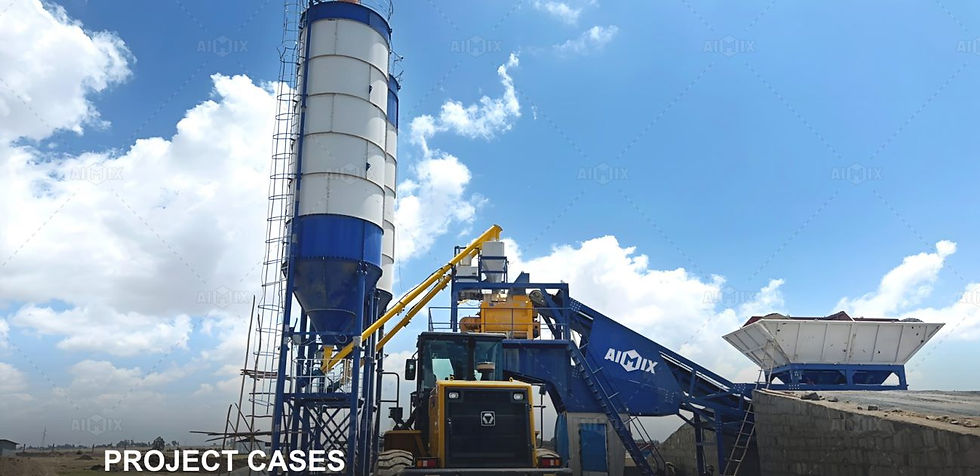Concrete Batching Plant for Sale: Innovations in Low-Carbon Concrete Production
- aimixglobal5
- Jul 27, 2025
- 3 min read
As the global construction industry strives toward greener practices, low-carbon concrete has emerged as a crucial innovation. Central to this transition is the concrete batching plant, which plays a pivotal role in the precise formulation and production of sustainable concrete mixtures. In recent years, growing environmental concerns and stricter carbon regulations have driven both governments and private sectors to seek innovative technologies that reduce emissions without compromising quality or performance.
For contractors, developers, and investors seeking a concrete batching plant for sale, understanding the latest innovations in low-carbon concrete production is essential. This article explores the emerging trends, technologies, and how modern plants—particularly those offered by China batching plant manufacturers—are driving the green transformation of the concrete sector.

Why Low-Carbon Concrete Matters
Traditional concrete production heavily relies on Portland cement, a material known for its high carbon footprint. Cement production alone contributes up to 8% of global CO₂ emissions. Low-carbon concrete addresses this issue by using alternative binders (such as fly ash, slag, or calcined clay), recycled aggregates, and optimized mix designs to significantly reduce emissions.
In this new paradigm, modern concrete batching plants must evolve to support new materials and processes—both at the hardware and software levels.
Technological Innovations in Batching Plants
To meet the demands of low-carbon concrete, leading concrete batching plant suppliers have introduced a series of cutting-edge upgrades, including:
1. Advanced Material Handling Systems
Modern batching plants can now precisely control the input of supplementary cementitious materials (SCMs) such as fly ash, silica fume, or GGBS (Ground Granulated Blast-furnace Slag). Accurate feeding systems ensure the consistent quality of green concrete mixes.
2. High-Efficiency Mixing Technologies
Innovative planetary or twin-shaft mixers ensure a thorough and homogeneous blend of materials, including recycled aggregates or lightweight additives. These mixers reduce mixing time while maintaining consistency—crucial for green concrete performance.
3. Automated Control Systems with Carbon Tracking
Many batching plants now feature AI-driven software and IoT integration that allow producers to track CO₂ emissions per batch. These systems can also optimize mixing sequences to reduce energy use and water consumption.
4. Integration with Renewable Energy Sources
Some batching plant models support operations powered by solar or hybrid energy systems, reducing reliance on fossil fuels at the plant level.

Role of China Batching Plant Manufacturers
China batching plant manufacturers are at the forefront of this innovation wave, offering high-tech, cost-effective, and scalable solutions tailored for low-carbon production. Known for rapid R&D cycles and strong global export capabilities, these suppliers have:
Developed plants that accommodate low-carbon cement alternatives.
Improved modular designs for easy transport and setup, especially in remote green projects.
Incorporated advanced dust control and wastewater recycling systems.
Major concrete batching plant suppliers in China, like Aimix, provide a wide range of models—from compact mobile units to large-scale stationary systems—that align with sustainability goals.
Practical Applications in Green Projects
Low-carbon concrete batching plants are being deployed in a variety of projects worldwide:
Infrastructure Projects: Bridges and highways now demand low-emission concrete formulations, especially in EU and North American markets.
Green Building Developments: LEED and BREEAM-certified buildings often require low-carbon construction materials.
Precast Manufacturing: Precast producers are adopting new batch technologies to meet green certification standards for building components.
Whether used on-site or in a ready mix concrete plant, these innovations significantly reduce environmental impact while delivering robust structural performance.
Selecting the Right Plant for Low-Carbon Goals
When looking for a concrete batching plant for sale, buyers should evaluate several key features that support low-carbon production:
Compatibility with SCMs and recycled materials
Energy-efficient operation and emission control
Automated systems for CO₂ tracking and water reuse
Reliable after-sales service and spare parts availability
Partnering with reputable concrete batching plant suppliers ensures that the plant not only meets production targets but also contributes to long-term environmental goals.

Conclusion
The demand for low-carbon concrete is reshaping the global construction equipment market, and the concrete batching plant sits at the heart of this transformation. Through innovations in material handling, energy efficiency, and automation, modern batching plants are enabling builders to meet strict environmental standards without sacrificing quality or efficiency.
For buyers seeking a concrete batching plant for sale, now is the time to invest in future-ready equipment. And with China batching plant manufacturers leading the charge in affordable and sustainable solutions, global access to low-carbon concrete technology is more achievable than ever.







Comments